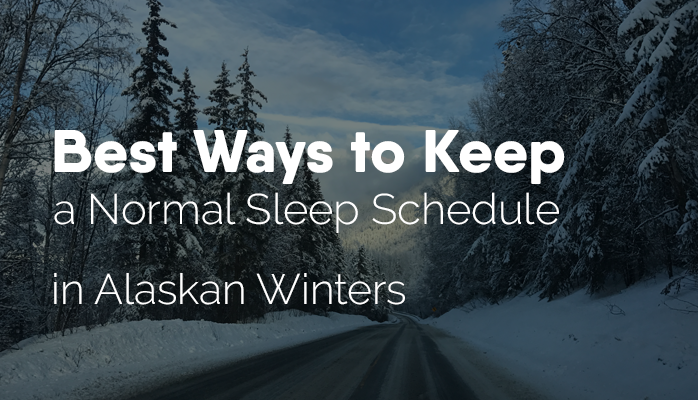Why Alaskan Winters Can Be Bad for Sleep
Much of the year in Alaska, we live in either the extreme darkness or extreme lightness. These extreme lighting conditions affect our lives psychologically, physiologically, habitually, emotionally, and sociologically.
Contrary to what you might think, the long darkness affects our lives in ways that aren’t conducive to sleep. Perhaps you suspect that you have developed a sleep disorder or your existing sleep disorder is worsening.
However, what may actually be happening is your sleep is distorted because of the difference in architecture of the day. This means that we have to work harder to maintain a normal sleep schedule in winter. The good news is that there are many tricks to you can use to help maintain a normal sleep schedule, though some people will need more direct intervention from sleep specialists or healthcare practitioners.
Signs the Alaskan Winter Darkness is Causing Sleep Disorder
Some signs that the long winter darkness may be causing or worsening a sleep disorder are:
- Never feeling like you get enough sleep – can’t fall asleep, stay asleep, or wake up too early
- General performance loss in many important areas of life (work, relationships, etc.)
- Chronic daytime fatigue
- Being unable to stay awake during the day
- Sudden onset of sleep-readiness at an odd hour during the day
- Uncharacteristic memory trouble
- Concentration problems
- Chronic brain fog
- Chronic headaches in the morning
- Increased anxiety that is not normal
- Depression
- Uncharacteristic mood troubles
If these symptoms hit or worsen during our long winters, it may be related to a sleep disorder. Below are the best ways to improve your sleep schedule or maintain a normal sleep schedule during Alaskan winters.
1 – Use Light Therapy in Alaska Winters
Light therapy is a very effective way to ensure that you are getting the requisite amount of light. Melatonin is a light-sensitive hormone that regulates sleep.
When dark transitions to light in the morning, it triggers your body to stop secreting melatonin. In the evening time, the opposite happens. Light therapy essentially tricks your body into thinking that sunlight is present when it isn’t. In Alaskan winters where sunlight may not come until 11am, noon, or never, this is an important trick.
Light therapy simply involves exposing yourself to bright fluorescent light bulbs encased in a box with a diffusing screen. This light is designed to simulate the intensity of sunlight (10,000 lux) in a way that is safe for the eyes. Timing is everything. Start exposing yourself to your light box in the morning, and stop exposing yourself in the evening.
You can find many light therapy lamps online for affordable prices.
2 – Establish Strong Pre-Bedtime Routines
Pre-bedtime routines are another way to trick your body into producing melatonin. Essentially, you are conditioning your body for sleep by using routines. Some routines can include:
- Take same actions before bed every evening
- Cut out blue light (TV, computers, smart phones) in the hour leading up to bed
- Using scents, such as essential oils
- Listen to the same music before bed
- Do a specific calming activity, such as meditation, washing, etc.
A great type of resource for learning how to establish strong pre-sleep routines is, believe it or not, websites discussing setting routines for sleep training children. They have great tips that can work for adults as well.
3 – Use Best Drinking Habits for Sleep
What you drink before bed can impact your ability to get a good night's rest. Here are the best drinking habits before bed:
- No alcohol right before bed
- Limit total caffeine intake
- Limit caffeine intake after noon
- Limit liquids directly before bed
Alcohol suppresses REM sleep. Too much coffee or coffee to late in the day keeps many people up. Too much liquid directly before bed may require you to wake up frequently to use the bathroom.
4 – Hot Bath Before Bed
Our body naturally prepares for sleep not just in response to light, but also in response to changes in temperature. Drops in temperature tell our bodies night is coming, and can help us transition to sleep.
Or course, unless you are camping or living without heat, our modern lives lack this change. However, you can simulate this change through bathing. When you get out of a hot bath before bed, your core body temperature drops, thus simulating what happens to temperatures at night. This drop in core temperature helps trick your body into thinking it’s time for bed.
5 – Try to Get Exercise
There’s no doubt, but winters in Alaska can cause sleep problems not just because of the darkness, but also the cold. The cold and darkness are the not the ideal environment to get exercise outdoors.
It’s harder. You have to put more clothes on. It’s not as comfortable as the spring and summer and your options are much more limited than when it’s warm.
For these reasons and more, we simply exercise less during the winter in Alaska. Exercise is very helpful for sleep. Find an activity outside you like such as cross country skiing, get a gym membership, and so on.
What to Do When These Sleep Practices Don’t Work
Sleep best practices and tricks won’t work for everyone. Some situations require more than self-conditions or preparing. If you have tried everything, you might consider talking with a healthcare provider who can put you in contact with a sleep specialist and get you a sleep study. Click the orange button below to take a free online sleep test and get in contact with one of our sleep health specialists!


